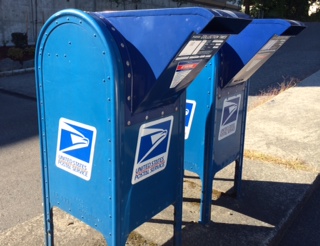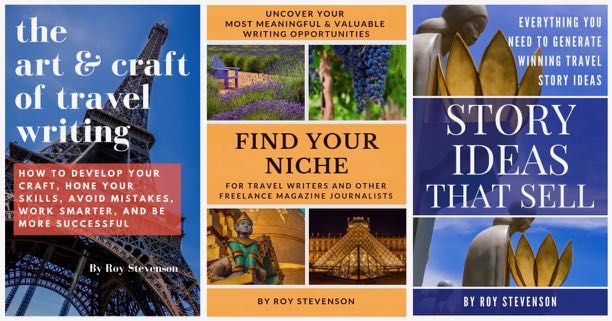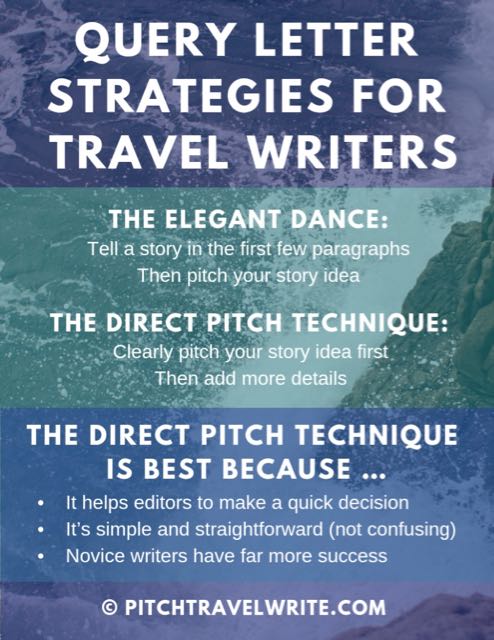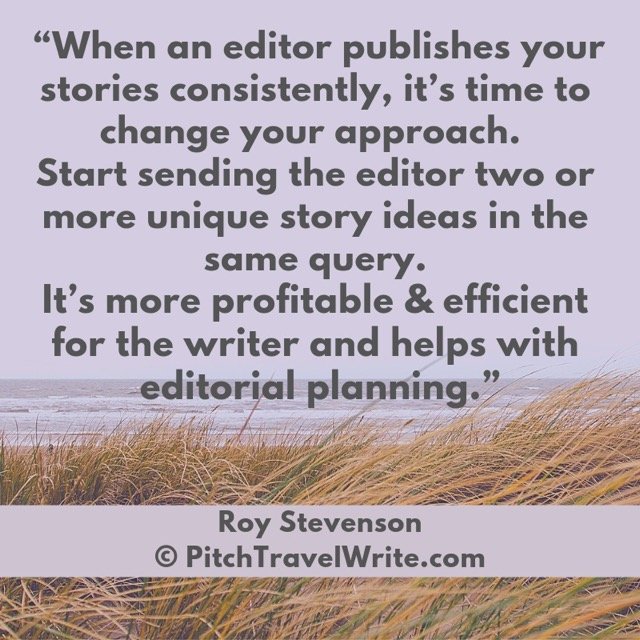- Home
- Query Letters
- Travel Writing Advice
Travel Writing Advice:
Turning Bad Tips into
Best Practices
By Roy Stevenson
I’m always looking for travel writing advice and new ideas on how to market my stories.
Over the years, I’ve made a point of reading every new book about how to succeed at travel writing. I have at least seven recently published books on my shelf, plus another half dozen general publications about freelance writing.
What strikes me when reviewing some of these books, is how shockingly bad or outdated some of the advice is in these published books. Some of the travel writing advice offered in these books is laughable, and some of it is simply counterproductive in today’s fluid freelance travel writing market.
Now, I don’t profess to know everything about marketing travel stories. And different techniques work for different people.
But, with my articles in more than 200 different publications, I’ve developed a strong sense
of what marketing techniques work and which ones don't work.
To help you recognize the bad advice that's out there and save you some time and trouble, I've compiled a list -- along with my advice and some best practices for what to do instead.
Here are six howlers that I’ve seen:
Travel Writing Advice - Bad Tip #1:
Submit Your Queries By Post
 Remember these? They're handy for some things but not for your query letters.
Remember these? They're handy for some things but not for your query letters.A couple of the books state that you should submit your queries by mail. And they don’t mean email. Seriously?
If a magazine doesn’t accept queries via email, what else don’t they do? Who has the time or desire to print off a query letter, address an envelope, and drive to the post office?
My Advice: avoid querying magazines that have not yet entered the 21st century.
Travel Writing Advice - Bad Tip #2:
Send Out One Query Letter at a Time
Another author recommends that you should send out one query letter to one editor at a time, and wait to hear back from that editor. After several weeks, when you have not heard back from the first editor, then you send the query letter out to the next editor on your distribution list, and so on.
Good luck with that one!
Most editors these days don’t bother replying to queries if they’re not interested. So you’re in for a very long wait if you expect to hear back from them.
This one-query-at-a-time query practice is archaic. You will rarely get published if you follow this advice.
The freelancer that wrote this book mentioned how many articles she’s had published in seven years. When I compared my total of published articles with hers, over the same time period, it was ten times higher.
My Travel Writing Advice: Simultaneous Submissions are accepted by modern travel writers as a best practice. Send your queries out, simultaneously, to every magazine where you believe your story would be a good fit. If you don’t use this method, you’ll grow old and gray before your published articles hit double figures.
Travel Writing Advice - Bad Tip #3:
Don’t Pitch the Same Query to All of Your Regional Magazines
One travel writing book I’ve read says we should NOT pitch the same article query to all the regional magazines on our distribution list. What? This advice doesn’t make sense.
My Advice: Query all the regional magazines with the same story idea (where it fits the style and focus of the magazine). It’s a numbers game. The more magazines you pitch, the more likely there will be one editor interested in your story.
For that matter, query all national and international magazines on your distribution lists with the same story idea. Use simultaneous submissions. As stated above, it's an accepted best practice.
Travel Writing Advice - Bad Tip #4:
For Simultaneous Submissions, When Your Article Is Accepted for Publication, Let the Other Editors Know
One author says that if you send out simultaneous submissions, and one editor goes for the article, you are obliged to email the rest of the editors and let them know your article has been taken.
Why would you bother to do this? It's a waste of time, in my opinion.
Editors will get back to you if they want your story. And conversely, editors who are not interested in your story will send you a rejection email, or completely ignore your pitch and delete it from their inbox.
After a short period of time, an editor’s silence should be taken as a sign that they are not interested in your article.
My Advice: Don’t make the extra effort of writing to the uninterested editors and retracting your pitch. You are not obliged to send them an email informing them that your story has been picked up elsewhere. It’s a waste of time.
Even worse, the editors will probably get annoyed and wonder whether you know what you’re doing.
Travel Writing Advice - Bad Tip #5:
In a Bad Economy, Focus Only on Regional Magazines
Another travel writing ‘expert’ says that during tough economic times you should focus only on regional magazines. I disagree.
In tough economic times the regional magazines are impacted significantly as their advertisers drop off. Some of the biggest shakedowns in recessions happen to smaller regional magazines. They have less of a financial buffer than the ‘biggies’ and fold in larger numbers.
My Advice: In tough economic times, expand your magazine base by writing in as many genres as interest you. Then, if one magazine folds, you still have plenty of other reliable magazines to fall back on.
Travel Writing Advice - Bad Tip #6:
When You Send Your Article to An Editor, Explain Why You Wrote It in a Particular Way
Discussing the editorial thrust of the article with the editor, before you write it, is a natural part of the freelance travel writing process. So, why should you explain this again when you submit your story?
This suggested practice shows a lack of confidence on the part of the writer. And, the editor is going to get annoyed at this superfluous fluff and consider it a waste of their time.
The editor wants to receive your well-written article and bank it until publication time.
My Advice: If you did the job you promised to do, no explanation is needed. The editor will get back to you if he has any questions. Put your energy, instead, into pitching another article query in your email.
Travel Writing Advice - Bad Tip #7:
Tell the Editor This is a Reprint
Some authors say that you should tell the editor if an article is a reprint. This is self-defeating. It’s an invitation to the editor to pay you less money. Why would you do this?
Just because your story has been published elsewhere doesn’t make it less valuable to a new set of readers. It’s not tarnished just because it was published somewhere else.
If you wrote the piece from scratch and retained the rights, it’s yours to sell again (and again).
Reselling your travel writing articles increases your income and saves you time. Just like anyone else, you deserve to earn income from your hard work. You are entitled to find ways to work productively. Reselling your articles to a different set of readers in another market is one way to do this.
After your work has appeared in a newspaper or magazine, the rights revert back to you (in most cases) and you’re then free to resell it. Before you sign a contract make sure you have the right to resell. Don’t sign away your rights unless you are being paid handsomely to do it.
My Advice: You don’t need to advertise your article as a reprint unless the editor specifically asks about it. As long as your article has not appeared in a competing magazine within the previous year or two, and as long as you retain the rights to your article, it is completely legitimate to resell it as your original work to anyone who is interested in purchasing it, and for whatever price they’re willing to pay.
Break into Travel Writing
with the Creative Pack
The Creative Pack includes 3 eBooks that are the starting point for every travel writer: dreaming up unique story ideas that you can sell, finding the best writing niches for you based on your interests, passions and experience, and the art & craft of travel writing. They’re the pieces of the puzzle that come before you ever write a query letter to sell your articles to magazine editors.
If you're just getting started in travel writing, this group of resources will help you improve your craft, generate story ideas that sell, and develop your own unique and meaningful niche.
These eBooks can be purchased separately, but when you buy the bundle you'll save more than 10% off individual prices! Learn more here ...

Roy Stevenson is a professional travel writer and the author of www.PitchTravelWrite.com. Over the past ten years, he’s had more than 1000 articles published in 200 magazines, trade and specialty journals, in-flights, on-boards, blogs and websites and has traveled on assignment around the U.S. and to dozens of international destinations.
IF YOU ENJOYED THIS POST, GET UPDATES. IT'S FREE.

















